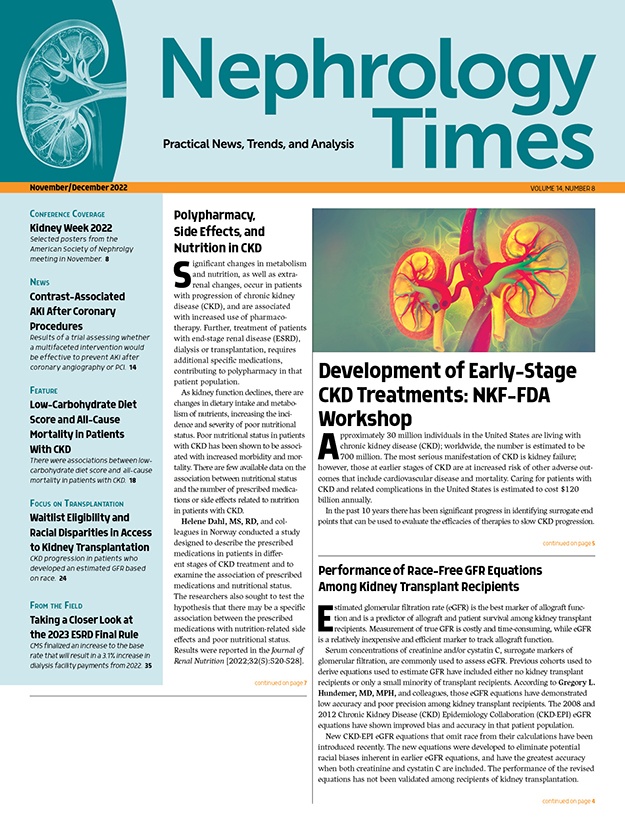
Among recipients of kidney transplantation, adherence to prescribed medication is key in graft survival as well as in treating comorbidities common in transplant recipients, including diabetes, hypertension, and dyslipidemia. Given the association between medication adherence and positive outcomes in transplant recipients, there are policies in place designed to encourage adherence.
Measures of adherence to oral medications for the treatment of diabetes, hypertension, and dyslipidemia are included in the Centers for Medicare & Medicaid Services (CMS) Five-Star Quality Ratings System (Star Ratings). The measures were developed by the Pharmacy Quality Alliance (PQA) in partnership with CMS
Star Ratings programs for Medicare Parts C and D (Medicare Advantage plans and Medicare prescription drug coverage, respectively) were created by CMS. Star Ratings range from one to five, with higher ratings indicating higher quality or better performance on Star Ratings measures.
There are two types of Part D plans: independent prescription drug plans (PDPs) and Medicare Advantage prescription drug plans (MAPDs). MAPDs receive bonus payments based on their Star Ratings; the plans are required to use the bonus payments to lower premiums and/or offer extra benefits to enrollees.
Not all patients enrolled in a MAPD are included in the assessment of each Star Rating measure for that MAPD. There are criteria developed by the PQA that define who qualifies for inclusion in the assessment of each rating on adherence. However, according to Marie A. Chisholm-Burns, PharmD, and colleagues, the criteria may have the unintended consequence of adding to racial and ethnic disparities in care by causing MPADs to concentrate on patients who meet the inclusion criteria and disincentivizing those who do not.
The researchers conducted a cross-sectional analysis designed to assess whether criteria for inclusion in the assessment of Star Ratings medication adherence measures among kidney transplant recipients with diabetes, hypertension, and/or dyslipidemia are associated with racial and ethnic disparities in which patients are included in the Star Ratings assessment. Results of the study were reported in the Journal of Managed Care & Specialty Pharmacy [2022;28(6):688-699].
The researchers utilized the 2017 Medicare Part D database linked to the Master Beneficiary Summary File, Parts A/B claims , and Area Health Resources Files. The Part D database includes data on dispensed prescriptions and drug costs for prescriptions paid for by the Part D program. The Medicare Beneficiary Summary Files includes demographic and enrollment data for Medicare recipients, and the Parts A and B claims provide diagnosis records for beneficiaries from inpatient and outpatient providers.
The outcomes of interest were the likelihood of being included in the assessment of Star Ratings Part D medication adherence measures for oral diabetes medications, hypertension medications (defined by the PQA as angiotensin 2 receptor blockers, angiotensin-converting enzyme inhibitors, and direct renin inhibitors), and statin medications to treat dyslipidemia.
The sample included 94,822 kidney transplant recipients with continuous coverage of Medicare Parts A/B/D who filled at least one prescription for diabetes, hypertension, or dyslipidemia in 2017. The majority of the eligible patients were White (51.4%), and 24.4% were Black. The White patient group was significantly older than all racial/ethnic groups (P<.0001). A larger proportion of Hispanic and other patients were male compared with White patients (P<.0001); a smaller proportion of Black patients were male compared with White patients (P<.05)
White patients were more likely to live in counties with higher proportions of married couples (P<.001) and individuals ≤25 years of age with at least a high school education (P<.05) compared with all racial and ethnic minority groups; more likely to live in countries with lower rates of uninsured individuals compared with Black, Hispanic, and other patients (P<.001); and more likely to live in counties with lower per capita income compared with Asian patients (P<.0001).
White patients had a significantly lower risk of adjustment summary score (higher risk adjustments indicate worse health status and greater expected healthcare costs) compared with Black patients (P<.0001).
Across all study cohorts, racial and ethnic minority patients had higher percentages of diagnosis of end-stage renal disease (ESRD) in the measurement year. In the hypertension-only cohort, the percentage of White patients with an ESRD diagnosis was 41.3%, compared with 66.9% of Black patients, 60.4% of Hispanic patients, 55.5% of Asian patients, and 62% of patients in other racial/ethnic groups (P<.05).
In chi-square analyses of patients with hypertension only and those with dyslipidemia only, all racial and ethnic minority groups were less likely to be included in assessments compared with White patients (P<.0001). Among patients with diabetes only, Black patients and Hispanic patients were less likely to be included than White patients (P<.0001). There were no significant differences between White patients and Asian patients or patients of other race/ethnicity.
Among patients with any two conditions (diabetes, hypertension, and/or dyslipidemia), compared with White patients, all racial and ethnic minority groups were less likely to be included in assessment of one or two Star Ratings measures (P<.0001). Among kidney transplant recipients with three conditions, all racial and ethnic patients were less likely than White patients to be included in assessment of one, two, or three Star Ratings measures (P<.05).
In adjusted analysis, Black and Hispanic kidney transplant recipients in the diabetes-only cohort were less likely than White patients to be included in the assessment of the Star Ratings adherence measure for oral diabetes medications (P<.0001); there were no significant differences between White patients and Asian and patients of other race/ethnicity. In the hypertension-only and dyslipidemia-only cohorts, all racial and ethnic minority groups were less likely than White patients to be included in assessments of the Star Ratings adherence measures for oral hypertension and dyslipidemia medications (P<.002).
The researchers cited some limitations to the study findings, including not directly examining who was and was not included in assessments of Star Ratings adherence measures across MAPDs, and the inability to definitively establish causality between criteria for inclusion in Star Ratings measure assessments and racial and ethnic disparities.
In conclusion, the authors said, “Racial and ethnic disparities exist among kidney transplant patients with diabetes, hypertension, and dyslipidemia regarding likelihood of inclusion in assessment of Star Ratings medication adherence measures. Future studies are needed to determine if not being included in assessment of Star Ratings measures contributes to disparities in assess to MAPD-provided services to support medication adherence and, ultimately, health outcomes among racial and ethnic minority patients who have received a kidney transplant.”
Takeaway Points
- Patients who have received a kidney transplant who are not included in assessment of Medicare Part D Star Ratings measures for medication adherence may face worse outcomes than those who are included.
- Researchers conducted a cross-sectional secondary analysis to examine whether criteria for inclusion in assessment of Medicare Part D Star Ratings medication adherence is associated with racial and ethnic disparities among kidney transplant recipients with diabetes, hypertension, and/or dyslipidemia.
- The findings suggest that kidney transplant recipients in racial and ethnic minority groups are less likely to be included in assessments of Star Ratings medication adherence measures.






 © 2025 Mashup Media, LLC, a Formedics Property. All Rights Reserved.
© 2025 Mashup Media, LLC, a Formedics Property. All Rights Reserved.